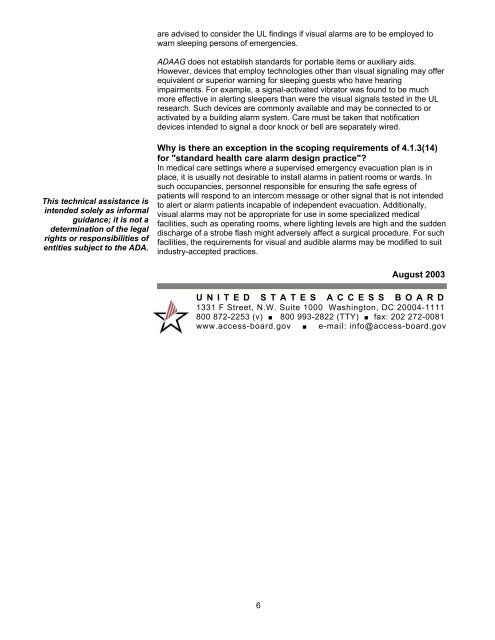Fire Protection Design Manual - Office of Construction and Facilities ...
Fire Protection Design Manual - Office of Construction and Facilities ...
Fire Protection Design Manual - Office of Construction and Facilities ...
Create successful ePaper yourself
Turn your PDF publications into a flip-book with our unique Google optimized e-Paper software.
This technical assistance is<br />
intended solely as informal<br />
guidance; it is not a<br />
determination <strong>of</strong> the legal<br />
rights or responsibilities <strong>of</strong><br />
entities subject to the ADA.<br />
are advised to consider the UL findings if visual alarms are to be employed to<br />
warn sleeping persons <strong>of</strong> emergencies.<br />
ADAAG does not establish st<strong>and</strong>ards for portable items or auxiliary aids.<br />
However, devices that employ technologies other than visual signaling may <strong>of</strong>fer<br />
equivalent or superior warning for sleeping guests who have hearing<br />
impairments. For example, a signal-activated vibrator was found to be much<br />
more effective in alerting sleepers than were the visual signals tested in the UL<br />
research. Such devices are commonly available <strong>and</strong> may be connected to or<br />
activated by a building alarm system. Care must be taken that notification<br />
devices intended to signal a door knock or bell are separately wired.<br />
Why is there an exception in the scoping requirements <strong>of</strong> 4.1.3(14)<br />
for "st<strong>and</strong>ard health care alarm design practice"?<br />
In medical care settings where a supervised emergency evacuation plan is in<br />
place, it is usually not desirable to install alarms in patient rooms or wards. In<br />
such occupancies, personnel responsible for ensuring the safe egress <strong>of</strong><br />
patients will respond to an intercom message or other signal that is not intended<br />
to alert or alarm patients incapable <strong>of</strong> independent evacuation. Additionally,<br />
visual alarms may not be appropriate for use in some specialized medical<br />
facilities, such as operating rooms, where lighting levels are high <strong>and</strong> the sudden<br />
discharge <strong>of</strong> a strobe flash might adversely affect a surgical procedure. For such<br />
facilities, the requirements for visual <strong>and</strong> audible alarms may be modified to suit<br />
industry-accepted practices.<br />
August 2003<br />
U N I T E D S T A T E S A C C E S S B O A R D<br />
1331 F Street, N.W. Suite 1000 Washington, DC 20004-1111<br />
800 872-2253 (v) ■ 800 993-2822 (TTY) ■ fax: 202 272-0081<br />
www.access-board.gov ■ e-mail: info@access-board.gov<br />
6

















